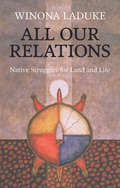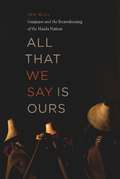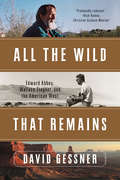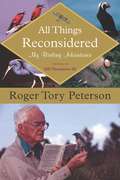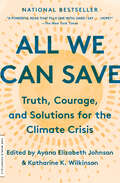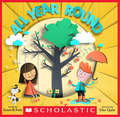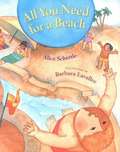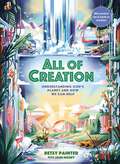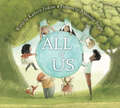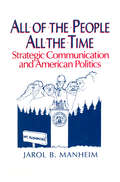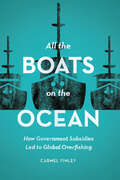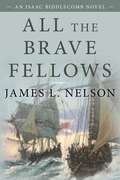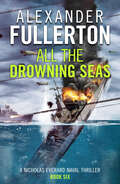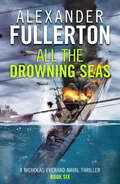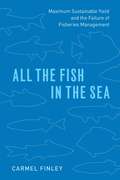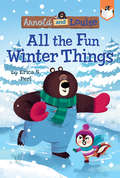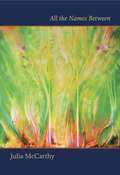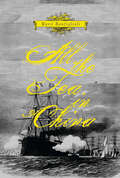- Table View
- List View
All Our Relations: Native Struggles for Land and Life
by Winona LaDukeHow Native American history can guide us today: “Presents strong voices of old, old cultures bravely trying to make sense of an Earth in chaos.” —Whole EarthWritten by a former Green Party vice-presidential candidate who was once listed among “America’s fifty most promising leaders under forty” by Time magazine, this thoughtful, in-depth account of Native struggles against environmental and cultural degradation features chapters on the Seminoles, the Anishinaabeg, the Innu, the Northern Cheyenne, and the Mohawks, among others. Filled with inspiring testimonies of struggles for survival, each page of this volume speaks forcefully for self-determination and community.“Moving and often beautiful prose.” —Ralph Nader“Thoroughly researched and convincingly written.” —Choice
All Pets Allowed: Blackberry Farm 2
by Adele GriffinNew dog, no tricks! Becket Branch has one birthday wish—a dog! Dogs are outgoing and friendly, and they live life loud, just like Becket. Becket&’s twin, Nicholas, wants a pet more like him—a peaceful, quiet indoor cat. When their parents take them to the shelter to choose a dog and a cat, it should be Becket&’s biggest BEAUTIFUL ALERT ever. But Becket&’s dream dog, Dibs, turns out to be a super-shy scaredy-pooch. Meanwhile, Nicholas&’s kitty, Given, loves being the center of attention and greeting visitors to Blackberry Farm. Can Becket and Nicholas learn how to love Dibs and Given as they are—even if they aren&’t exactly the pets the twins dreamed of? With black-and-white drawings throughout by award-winning illustrator LeUyen Pham (Real Friends), this second volume of the Blackberry Farm series offers a gentle message about embracing new friends who may not match preconceived expectations.
All That We Say Is Ours
by Ian GillHaida Gwaii, also known as the Queen Charlotte Islands, is the Galapagos of the north. Famous for their wild beauty, the islands are also the ancient homeland of the Haida Nation. Integral to Haida culture is the relationship to the land, and the Haidas have spent many years trying to protect and recover control of it. Under the leadership of Giindajin Haawasti Guujaaw, the visionary artist, drummer, and orator, the Haida blockaded loggers, joined forces with environmentalists, lobbied political leaders, and in 2004 filed suit against the Canadian government, laying claim to their entire traditional territory. Ian Gill captures the excitement of the Haida struggle and their passion for their culture. He also reveals the making of an artist and political activist: Guujaaw's audacity, eloquence, tactical skills, and deep knowledge of his homeland place him at the heart of this riveting story, and this book reveals his extraordinary role in it.
All That We Share: How to Save the Economy, the Environment, the Internet, Democracy, Our Communities and Everything Else That Belongs to All of Us
by Jay WalljasperThe commons encompasses everything that is jointly owned by all of us, from gifts of nature, such as the airwaves and DNA, to products of human creativity and scientific knowledge, such as dance steps, religious traditions, and open-source software. In this introduction for general readers, Walljasper, a fellow at On the Commons (a commons movement strategy center) explains general concepts of the commons and why it matters, warning that much of the commons is under threat due to private interests. The book consists of short essays illustrated with b&w photos in a lively, reader-friendly layout. Many of the essays are credited to Walljasper and other writers from On the Commons, but others are excerpts from thinkers such as Jeremy Rifkin, Robert F. Kennedy Jr., and Winona LaDuke. Interspersed throughout the book are profiles of contemporary commons champions and boxes on real-life cases from around the country and around the world, such as an indigenous bill of rights, the Pacific Forest Trust, and the great Facebook rebellion. The book closes with advice for what ordinary people can do to restore the commons. Appendices offer a commons dictionary and a list of movies, novels, music, and art that evoke a spirit of sharing. Accessible to high school students and up, the book can be used as a supplemental text or for individual readers. Walljasper is former editor of Utne Reader. Annotation ©2011 Book News, Inc., Portland, OR (booknews.com)
All That the Rain Promises and More: A Hip Pocket Guide to Western Mushrooms
by David Arora&“[All That the Rain Promises and More] is certainly the best guide to fungi, and may in fact be a long lasting masterpiece in guide writing for all subjects.&”—Roger McKnight, The New York TimesMushrooms appeal to all kinds of people—and so will this handy pocket guide, which includes key information for more than 200 Western mushroomsOver 200 edible and poisonous mushrooms are depicted with simple checklists of their identifying features, as David Arora celebrates the fun in fungi with the same engaging bend of wit and wisdom, fact and fancy, that has made his comprehensive guide, Mushrooms Demystified, the mushroom hunter&’s bible.&“The best guide for the beginner. I&’d buy it no matter where I lived in North America.&”—Whole Earth Catalog
All The Wild That Remains: Edward Abbey, Wallace Stegner, and the American West
by David GessnerAn homage to the West and to two great writers who set the standard for all who celebrate and defend it. Archetypal wild man Edward Abbey and proper, dedicated Wallace Stegner left their footprints all over the western landscape. Now, award-winning nature writer David Gessner follows the ghosts of these two remarkable writer-environmentalists from Stegner's birthplace in Saskatchewan to the site of Abbey's pilgrimages to Arches National Park in Utah, braiding their stories and asking how they speak to the lives of all those who care about the West. These two great westerners had very different ideas about what it meant to love the land and try to care for it, and they did so in distinctly different styles. Boozy, lustful, and irascible, Abbey was best known as the author of the novel The Monkey Wrench Gang (and also of the classic nature memoir Desert Solitaire), famous for spawning the idea of guerrilla actions--known to admirers as "monkeywrenching" and to law enforcement as domestic terrorism--to disrupt commercial exploitation of western lands. By contrast, Stegner, a buttoned-down, disciplined, faithful family man and devoted professor of creative writing, dedicated himself to working through the system to protect western sites such as Dinosaur National Monument in Colorado. In a region beset by droughts and fires, by fracking and drilling, and by an ever-growing population that seems to be in the process of loving the West to death, Gessner asks: how might these two farseeing environmental thinkers have responded to the crisis? Gessner takes us on an inspiring, entertaining journey as he renews his own commitment to cultivating a meaningful relationship with the wild, confronting American overconsumption, and fighting environmental injustice--all while reawakening the thrill of the words of his two great heroes.
All Things Bright and Beautiful
by Ashley Bryan Cecil F. AlexanderAll things bright and beautiful; all creatures great and small; all things wise and wonderful, the incredible Ashley Bryan illustrates them all!
All Things Harmless, Useful, and Ornamental: Environmental Transformation through Species Acclimatization, from Colonial Australia to the World (Flows, Migrations, and Exchanges)
by Pete MinardSpecies acclimatization--the organized introduction of organisms to a new region--is much maligned in the present day. However, colonization depended on moving people, plants, and animals from place to place, and in centuries past, scientists, landowners, and philanthropists formed acclimatization societies to study local species and conditions, form networks of supporters, and exchange supposedly useful local and exotic organisms across the globe. Pete Minard tells the story of this movement, arguing that the colonies, not the imperial centers, led the movement for species acclimatization. Far from attempting to re-create London or Paris, settlers sought to combine plants and animals to correct earlier environmental damage and to populate forests, farms, and streams to make them healthier and more productive. By focusing particularly on the Australian colony of Victoria, Minard reveals a global network of would-be acclimatizers, from Britain and France to Russia and the United States. Although the movement was short-lived, the long reach of nineteenth-century acclimatization societies continues to be felt today, from choked waterways to the uncontrollable expansion of European pests in former colonies.
All Things Reconsidered: My Birding Adventures
by Roger Tory PetersonRoger Tory Peterson’s unique perspective on birding comes to life in these highly personal narratives. Here he relates his adventures during a lifetime of birding and traveling the world to observe and record nature. Though Peterson was widely known for his illustrations, this collection reminds us to reconsider his accomplishments as a photographer, for Peterson was nearly as passionate about photography as he was about painting. The essays and photographs included here were carefully selected by Bill Thompson III, the editor of Bird Watcher’s Digest, which ran the column “All Things Reconsidered” during the last twelve years of Peterson’s life.
All We Can Save: Truth, Courage, and Solutions for the Climate Crisis
by Ayana Elizabeth Johnson Katharine K. WilkinsonProvocative and illuminating essays from women at the forefront of the climate movement who are harnessing truth, courage, and solutions to lead humanity forward. There is a renaissance blooming in the climate movement: leadership that is more characteristically feminine and more faithfully feminist, rooted in compassion, connection, creativity, and collaboration. While it&’s clear that women and girls are vital voices and agents of change for this planet, they are too often missing from the proverbial table. More than a problem of bias, it&’s a dynamic that sets us up for failure. To change everything, we need everyone. All We Can Save illuminates the expertise and insights of dozens of diverse women leading on climate in the United States—scientists, journalists, farmers, lawyers, teachers, activists, innovators, wonks, and designers, across generations, geographies, and race—and aims to advance a more representative, nuanced, and solution-oriented public conversation on the climate crisis. These women offer a spectrum of ideas and insights for how we can rapidly, radically reshape society. Intermixing essays with poetry and art, this book is both a balm and a guide for knowing and holding what has been done to the world, while bolstering our resolve never to give up on one another or our collective future. We must summon truth, courage, and solutions to turn away from the brink and toward life-giving possibility. Curated by two climate leaders, the book is a collection and celebration of visionaries who are leading us on a path toward all we can save. With essays and poems by:Emily Atkin • Xiye Bastida • Ellen Bass • Colette Pichon Battle • Jainey K. Bavishi • Janine Benyus • adrienne maree brown • Régine Clément • Abigail Dillen • Camille T. Dungy • Rhiana Gunn-Wright • Joy Harjo • Katharine Hayhoe • Mary Annaïse Heglar • Jane Hirshfield • Mary Anne Hitt • Ailish Hopper • Tara Houska, Zhaabowekwe • Emily N. Johnston • Joan Naviyuk Kane • Naomi Klein • Kate Knuth • Ada Limón • Louise Maher-Johnson • Kate Marvel • Gina McCarthy • Anne Haven McDonnell • Sarah Miller • Sherri Mitchell, Weh&’na Ha&’mu Kwasset • Susanne C. Moser • Lynna Odel • Sharon Olds • Mary Oliver • Kate Orff • Jacqui Patterson • Leah Penniman • Catherine Pierce • Marge Piercy • Kendra Pierre-Louis • Varshini • Prakash • Janisse Ray • Christine E. Nieves Rodriguez • Favianna Rodriguez • Cameron Russell • Ash Sanders • Judith D. Schwartz • Patricia Smith • Emily Stengel • Sarah Stillman • Leah Cardamore Stokes • Amanda Sturgeon • Maggie Thomas • Heather McTeer Toney • Alexandria Villaseñor • Alice Walker • Amy Westervelt • Jane Zelikova
All Year Round: A Story of the Seaons
by Susan B. KatzFollow two friends as they explore the changing seasons through the beauty of each month's iconic shapes and celebrations -- from January to December -- all year round.A world of shapes, twelve months abound,from four-cornered square, to circle, round.Circle round, ready to roll. Add two sticks, a carrot and coal. (January)A sporty diamond, player at bat. Bases loaded, tilt your hat. (June)Triangle treats-pumpkin, peach. Want some pie? Excuse my reach! (November)Poetic text by Susan B. Katz (ABC Baby Me!, My Mama Earth, ABC School's for Me) is paired with debut illustrator Eiko Ojala's intricate cut-paper artwork to bring the months and their shapes to life! Bold colors, adorable characters, and lyrical text fuse together perfectly in this truly creative look at the world around us.
All You Need for a Beach
by Alice SchertleThere's nothing quite like a day at the beach! And Alice Schertle and Barbara Lavallee's clever companion toAll You Need for a Snowmanis the perfect recipe for fun in the sun. Plant a yellow umbrella in the sand, roll out a beach towel, and pour a glass of frosty lemonade. . . . But wait! What's the most important part of a beach? A surprise ending will inspire young adventurers everywhere to don their shades and head for the beach.
All You Need for a Snowman
by Alice SchertleAges 2-5 One small snowflake fluttering down-- that's all you need for a snowman. EXCEPT bottle caps, a carrot walnuts, a scarf, a fanny pack, mittens . . . and that's all. Or is it?
All of Creation: Understanding God’s Planet and How We Can Help
by Betsy PainterFrom conservation to protecting endangered species to sustainable living, All of Creation offers young readers accessible and fascinating information on the challenges our planet faces and practical ways we can care for the magnificent world around us.Drawing on science and Scripture, this hope-filled and kid-friendly guide to planet Earth addresses our most pressing questions about caring for and respecting God's world, such as:What are the biggest challenges our planet faces, and what impact do they have on our lives?What guidance does the Bible offer to help us navigate environmental issues such as pollution, food shortages, and deforestation?What simple choices can we make to help restore and protect God's creation? Gorgeously detailed illustrations throughout highlight the beauty of the natural world, while practical tips and activities at the end of each chapter show how we can become better stewards of the Earth and support efforts that make a positive difference in the world.All of Creation is ideal for:Readers ages 8-12 who are interested in conservation and the environmentYoung people who want to get involved but don&’t know where to startGift-giving occasions such as birthdays, Christmas, Easter, and other holidays
All of Us
by Kathryn ErskineA beautiful book about community and love by National Book Award winner Kathryn Erskine and #1 New York Times bestselling illustrator Alexandra Boiger.ME can be WE. YOU can come, too. In a lyrical text that travels the globe, National Book Award winner Kathryn Erskine shows young readers how the whole world is a community made up of people who are more similar than we are different. With stunning, cinematic art by Alexandra Boiger, the illustrator of the She Persisted series, this is the perfect read-aloud at bedtime or for story time. Perfect for fans of All Are Welcome and Be Kind. Praise for All of Us: * "[In this] book about global inclusivity . . . the breathtaking art carries the message throughout." --Booklist, starred review * "This simple yet beautiful book reminds readers that they are not alone. . . . Children will find something different every time they read the poem, and feel cherished by the message of openness." --School Library Journal, starred review"A lyrical celebration of unity and diversity . . . Purely sweet." --Kirkus Reviews "This picture book offers an uplifting vision for a unified world." --Publishers Weekly
All of the People, All of the Time: Strategic Communication and American Politics
by Jarol B. ManheimThis book is about the uses and abuses of political communication in contemporary American society, employing numerous anecdotes and examples and drawings upon the latest research and theories of communication and political science in America.
All the Boats on the Ocean: How Government Subsidies Led to Global Overfishing
by Carmel FinleyMost current fishing practices are neither economically nor biologically sustainable. Every year, the world spends $80 billion buying fish that cost $105 billion to catch, even as heavy fishing places growing pressure on stocks that are already struggling with warmer, more acidic oceans. How have we developed an industry that is so wasteful, and why has it been so difficult to alter the trajectory toward species extinction? In this transnational, interdisciplinary history, Carmel Finley answers these questions and more as she explores how government subsidies propelled the expansion of fishing from a coastal, in-shore activity into a global industry. While nation states struggling for ocean supremacy have long used fishing as an imperial strategy, the Cold War brought a new emphasis: fishing became a means for nations to make distinct territorial claims. A network of trade policies and tariffs allowed cod from Iceland and tuna canned in Japan into the American market, destabilizing fisheries in New England and Southern California. With the subsequent establishment of tuna canneries in American Samoa and Puerto Rico, Japanese and American tuna boats moved from the Pacific into the Atlantic and Indian Oceans after bluefin. At the same time, government subsidies in nations such as Spain and the Soviet Union fueled fishery expansion on an industrial scale, with the Soviet fleet utterly depleting the stock of rosefish (or Pacific ocean perch) and other groundfish from British Columbia to California. This massive global explosion in fishing power led nations to expand their territorial limits in the 1970s, forever changing the seas. Looking across politics, economics, and biology, All the Boats on the Ocean casts a wide net to reveal how the subsidy-driven expansion of fisheries in the Pacific during the Cold War led to the growth of fisheries science and the creation of international fisheries management. Nevertheless, the seas are far from calm: in a world where this technologically advanced industry has enabled nations to colonize the oceans, fish literally have no place left to hide, and the future of the seas and their fish stocks is uncertain.
All the Brave Fellows: An Isaac Biddlecomb Novel (Isaac Biddlecomb Novels)
by James L. NelsonIt is 1777, the Year of the Hangman, and Captain Isaac Biddlecomb is bound for Philadelphia with his wife and child in the Continental brig Charlemagne. His orders are to take command of the newly built 20-gun frigate Falmouth and get her out to sea before she is taken by General Richard Howe's invading army.Unbeknownst to Biddlecomb, the entire British fleet stands between him and the new nation's capital. Forced to run his beloved Charlemagne aground, Biddlecomb comes face-to-face with his mortal enemy, Royal Navy Lieutenant John Smeaton. Meanwhile, General Washington has yielded Philadelphia to Britain's might. As Biddlecomb and his crew battle to reach the prized Falmouth, only shipwright Malachi Foote and a ragtag band of deserters from the Continental Army stand between the vessel and the seemingly unstoppable British Army.
All the Drowning Seas (Nicholas Everard Naval Thrillers)
by Alexander FullertonThe sixth thrilling instalment of the Nicholas Everard thrillers.1942. As Japanese invasion fleets sweep across the Pacific, a handful of Allied ships prepare for a last-ditch battle at Surabaya in the Java Sea. Not only is the Allied force doomed to defeat: any surviving ships will be trapped, since escape routes are blocked by the enemy.Nick Everard, commanding the cruiser Defiant, is badly wounded in the battle. His ship is heavily damaged and to make matters worse, he has a battered US destroyer under his protection. But unless Everard can find some way out of the trap, both ships and crews face destruction…All the Drowning Seas presents compelling action at sea, and establishes Alexander Fullerton as one of the premier novelists of naval warfare. Praise for Alexander Fullerton‘The prose has a real sense of urgency, and so has the theme. The tension rarely slackens.’ Times Literary Supplement
All the Drowning Seas: The Nicholas Everard World War Ii Saga Book 3 (Nicholas Everard Naval Thrillers)
by Alexander FullertonThe sixth thrilling instalment of the Nicholas Everard thrillers. 1942. As Japanese invasion fleets sweep across the Pacific, a handful of Allied ships prepare for a last-ditch battle at Surabaya in the Java Sea. Not only is the Allied force doomed to defeat: any surviving ships will be trapped, since escape routes are blocked by the enemy. Nick Everard, commanding the cruiser Defiant, is badly wounded in the battle. His ship is heavily damaged and to make matters worse, he has a battered US destroyer under his protection. But unless Everard can find some way out of the trap, both ships and crews face destruction… All the Drowning Seas presents compelling action at sea, and establishes Alexander Fullerton as one of the premier novelists of naval warfare. Praise for Alexander Fullerton &‘The prose has a real sense of urgency, and so has the theme. The tension rarely slackens.&’ Times Literary Supplement
All the Fish in the Sea: Maximum Sustainable Yield and the Failure of Fisheries Management
by Carmel FinleyBetween 1949 and 1955, the State Department pushed for an international fisheries policy grounded in maximum sustainable yield (MSY). The concept is based on a confidence that scientists can predict, theoretically, the largest catch that can be taken from a species’ stock over an indefinite period. And while it was modified in 1996 with passage of the Sustained Fisheries Act, MSY is still at the heart of modern American fisheries management. As fish populations continue to crash, however, it is clear that MSY is itself not sustainable. Indeed, the concept has been widely criticized by scientists for ignoring several key factors in fisheries management and has led to the devastating collapse of many fisheries. Carmel Finley reveals that the fallibility of MSY lies at its very inception—as a tool of government rather than science. The foundational doctrine of MSY emerged at a time when the US government was using science to promote and transfer Western knowledge and technology, and to ensure that American ships and planes would have free passage through the world’s seas and skies. Finley charts the history of US fisheries science using MSY as her focus, and in particular its application to halibut, tuna, and salmon fisheries. Fish populations the world over are threatened, and All the Fish in the Sea helps to sound warnings of the effect of any management policies divested from science itself.
All the Fun Winter Things #4 (Arnold and Louise)
by Erica S. PerlThere's too much fun to be had in the snow to sleep through the winter season! At least that's what Louise thinks. In this story designed to engage early readers, charming characters combine with simple text, lively illustrations, and laugh-out-loud humor to help boost kids' confidence and create lifelong readers!Snow has fallen and the pond is frozen, so Arnold knows that--as a bear--it's time to hibernate! But Louise insists that he'll miss all the fun winter things if he does, so she convinces him to try hibernating like a chipmunk instead. They'll sleep for a short time, wake up to go sledding or have a snowball fight, and repeat! The only problem is, Arnold can't seem to keep his eyes open. What if he can't stay awake for the winter fun? Exciting, easy-to-read books are the stepping stone a young reader needs to bridge the gap between being a beginner and being fluent.
All the Names Between
by Julie McCarthyPoems that form an eloquent, searching contemplation of “the warp and weft of being and nonbeing.” All the Names Between is Nova Scotia poet Julia McCarthy’s meditative and crackling-with-dark-energy third collection. From her observation of “long-horned beetles... rearranging the landscape” to an apperception of “part of me /...seeded by dust / of meteors and asteroids,” McCarthy makes palpable, in richly layered imagery and with attentiveness that unfolds stillness, the “Singing Emptiness” that informs and quickens the crow’s flight, the stones’ weight, and our own being as we move in “the defined world both elegant / and maimed.” Concerned with both the inadequacy and the necessity of word to convey world, the poems move through a shifting landscape of seasons and creatures, of the remembered dead, and of scattered stones reading the Akashic field. Grounded in the experience of presence, where the external and internal meet, a crossroads of consciousness where “a language without a name / remembers us” and the poem is a votive act, All the Names Between reflects the shadow-light of being, of what is and what isn’t, the seen and the unseen, the forgotten and the remembered where every elegy has an ode at its centreevery ode has an elegy around its edges. (from “Ode with an Elegy around its Edges”) Praise for All the Names Between: “It is Julia McCarthy’s incomparable eloquence as a poet to, as an experienced photographer might, wield darkness as an ever more powerful lens to reveal the intricate beauty of the world as she finds it. And it is with this extraordinary vision, that McCarthy ushers us into her newest collection, All the Names Between, ‘where the dead gather like trees in their white coats’ and bats hover overhead, ‘lucifugal as ashes from invisible fires.’ These are poems scintillate with vision and stunningly intimate—showing us page after page the full, and exquisite measure of ‘night’s worth.’” —Clarise Foster, Editor, Contemporary Verse 2 “Here is a book of meditations for even those immune to poetry, a poetry with no comfort zones. McCarthy takes readers to a world where the marriage between solitude and nature gives birth to memorable, haunting lines, where the mystery of poetry lies just between the words. I have no doubt readers will embrace this book as their own.” —Goran Simić, author of Immigrant Blues and From Sarajevo, with Sorrow
All the Tea in China: A Charlie Mortdecai novel (Mortdecai)
by Kyril BonfiglioliAll the Tea in China - a Mortdecai novel by Kyril Bonfiglioli, soon to be a major film starring Johnny Depp'One of the funniest writers ever' UncutAfter committing a crime anyone but a close relative might forgive, Karli Mortdecai Van Cleef leaves Holland double-quick with his uncle's buckshot lodged firmly in the seat of his breeches. Discretion being the least-idiotic part of valour he decides to hide far away in London, among the tea shops and opium dens. On savouring these Eastern delicacies and knowing an opportunity when he sups upon one, young Karli throws in his lot with an opium clipper bound for China's high seas.Life on the ocean waves, however, is full of perils for an officer and his sensitive digestive tract: mountainous waves, an encounter with a malodorous slave ship, the captain's wife's pulse-racingly brief wardrobe, several hordes of pirates, mutiny, the ship's cook's fondness for curry - to name but a few.All the Tea in China is a swaggering, rip-snorting, buckler-swashing tale about one of the men who - for a reasonable fee - made Britain great.'For those who have learnt to relish his elegant, nasty thrillers, Bonfiglioli is a name hard to forget. This farrago represents a change from the thrillers - a good clean salt-water yarn for the decadent' Irish Press'Shows his customary inventive comedy and zest for language' Sunday Times'Bonfiglioli deserves better than cult status' IndependentKyril Bonfiglioli was born on the south coast of England in 1928 of an English mother and Italo-Slovene father. After studying at Oxford and five years in the army, he took up a career as an art dealer, like his eccentric creation Charlie Mortdecai. He lived in Oxford, Lancashire, Ireland and Jersey, where he died in 1985. He wrote four Charlie Mortdecai novels, and a fifth historical Mortdecai novel (about a distinguished ancestor).
All the Tea in China: A Novel
by Kyril BonfiglioliA Dutchman seeks his fortune in hilarious, ironical, maritime, historical romp that&’s Master and Commander by way of Monty Python. Inspired by a shotgun blast in the seat of his breeches, young Karli Van Cleef quits his native Holland to seek his fortune. He arrives in early Victorian London and soon he is turning a pretty profit. But Karli sees that true opportunity flowers in India&’s fields of opium poppies and the treaty ports of the China coast. So, he takes a berth in an opium clipper hell-bent for the Indies. It is a journey beset with perils. Karli is confronted by the mountainous seas, high-piled plates of curry, and the ferocious penalties of the Articles of War. He survives the malice of the Boers, the hospitality of anthropophagi, and the horrors of Lancashire cooking. En route he acquires some interesting diseases, dangerous friends and enemies, a fortune, and a wife almost as good as new.Praise for All the Tea in China&“Bonfiglioli . . . offers a surfeit of delights in this historical romp, first published in 1978. . . . Bonfiglioli colors his picaresque with an abundance of wit and narrative verve. Indeed, the novel often reads like an unapologetically bawdy Pirates of the Caribbean.&” —Publishers Weekly&“This swashbuckling, mildly ribald adventure will appeal to teens who like historical fiction with a strong plot. With pirates continuing to be popular and the unlikelihood that libraries still own this—or ever did—for teens, young adult collection developers should take note.&” —School Library Journal
